Before Christmas, and after months of lockdown in Auckland, I took the opportunity to spend a couple of days over on Waiheke Island, with Gabor along to unlock a few doors. With a reputation for uncompromising attention to detail – as I edit this article to put online, they have just taken the step to remove the capsule from their wines – considering that it had very little to offer in today’s world of wine, and was therefore not needed (see the photo of Magna Praemia further down). It’s the little things that make a difference. Destiny Bay had recently been named by Bob Campbell MW as “Winery of the Year” in his Real Review website.
I’ve met the owner Sean Spratt a few times at various tastings, and I scored an invite to come over and take a look around. We drive up to the top of the property, overlooking the vineyards. We are surrounded by water, most of it only a few hundred metres away. The view is gorgeous.
Destiny Bay was born after founders Ann and Michael Spratt (Sean’s parents), visited Waiheke Island in 1998 and they fell in love with the place. Sean describes talking to a friend that night. “He asked me ‘how was your parents trip to New Zealand?’ And I said ‘they’re gonna move’. To this day they said they had no intention or knew that that was the case, but I could smell it on them. Just from picking them up at the airport and the ride back. So they say that was absolutely not in the plans – but I get to say that I was right”.
A second trip was planned for the following year – this time with Sean in tow. They found a parcel of land for sale – just on the hill above the current vineyard. The plan was simple to build a house up there. And all the land below was just grazing and cattle land. When that land also became available, they decided to buy it, thinking that since there were some good vineyards and wineries on the island, they might put a few vines in the backyard and make some wine in the garage as a hobby project.
Obviously it was a bright idea to find out whether the land was a good place (or a bad place) for growing grapes, first. They met Dr David Jordan and he was asked to come out and make an assessment. After he took a look, he said “It’s not good… it’s fantastic!” Especially for growing red varietals. He said that if we weren’t going to be planting grapes that he certainly knew people who would be interested in leasing the land and doing that. Once they realised that the site had some potential to do something – not just OK, but special – that was when it started to take more of a serious turn.
There isn’t a flat piece of land on the entire vineyard. Everything has got a slope one way or another – so, natural drainage. We’re standing on the steepest part of the vineyard overlooking a 38 degrees hill… but even the ‘flat part’ of the vineyard, which is the Merlot, still has a degree or two of slope.
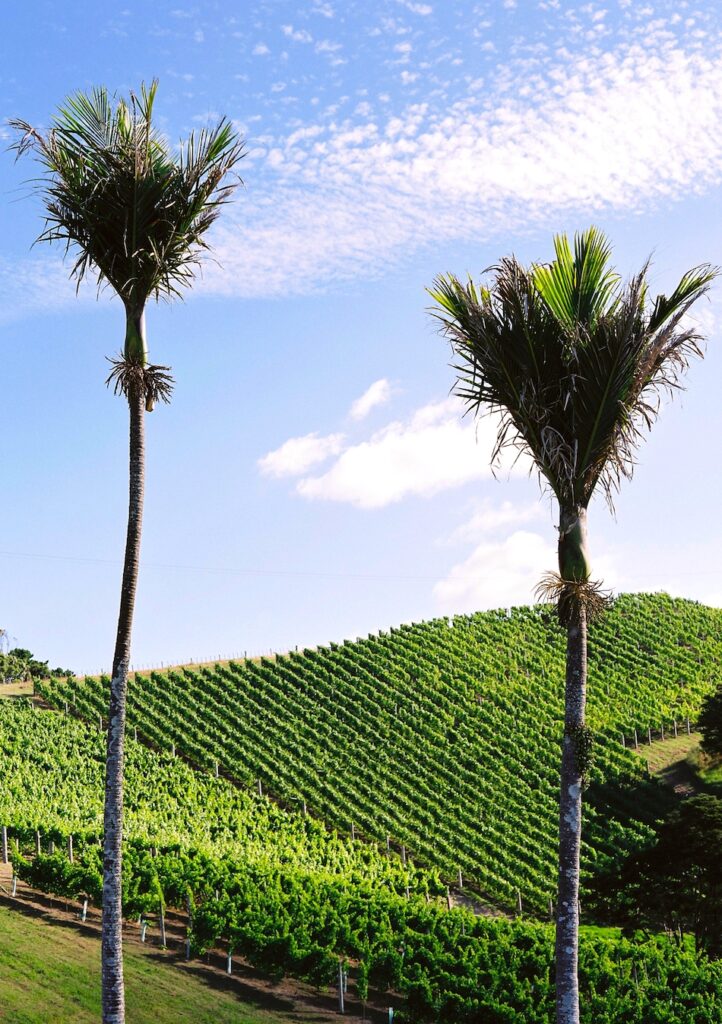
I ask Sean if the vineyard divided up specifically, so that each variety – and the clones of those varieties – get the best for what it needs?
Sean: “We’ve got about 20% Merlot planted, and there was only really one obvious choice, which is the 181-481 clone, which comes from a little Chateau that’s got a reputation for making a decent Merlot every once in a while. So we figured if it is good enough for Petrus, it’s good enough for us. That block is called the Millennium Block, because it was planted in 2000. About 60% Cabernet Sauvignon, 20% Merlot, and then a little bit less than 10% each of Malbec and Franc, and the last little bit of Petit Verdot to round it out.
The smaller octagonal-shaped block over there – that is the Tui Block, and that is Malbec, of two different French clones. The larger block at the top there that is in desperate need of a trim – is Cabernet Sauvignon Clone 15. And then this very large block here is Waina Motu block and it is Clone 15 with some LC10 which is Langhorne Creek (Australia). The Clone 15 we get the darker berry, currant aromas. The Langhorne Creek is smaller berries, smaller clusters and it is more Cabernet typicity – floral, herbal and peppery notes. We can use all these descriptors, but I talk about Cabernet typicity, and once you know what good Cabernet tastes like – it has its own flavour and aroma”.
The vineyard and winery is 100% sustainable, and Sean’s team have always been focussed on what is good for the environment. Not just for the ethical reasons, but what makes a happy and healthy environment makes for happy and healthy grapes. All harvesting is done by hand. They also do most of the canopy management by hand – the exception is that trimming is done mechanically, and a little bit of mechanical leaf plucking, but then go through and round that out by hand. All of this makes it quite labour intensive on the vineyard management side.
I quiz Sean about how how his wine journey started – was it after this place was unearthed and became a vineyard, or had he been looking at that before that?
Sean: “This sort of goes back to how did we get the name ‘Destiny Bay’ and why is the vineyard called that? We didn’t come here with grand plans to start a vineyard and make New Zealand’s best Cabernet Sauvignon. It really happened quite serendipitously to find out there was this amazing site.
Personally, I grew up and around the California wine industry. My Grandfather and uncle were avid wine collectors going back into the ‘70s. My Grandfather was an artist and was determined to raise me the proper European way, so by the time I was seven I was getting served wine and being asked to help pick out wines from his cellar.
When this became a full project, my Father said “hey, you know that little hobby vineyard project we were talking about…would you have any interest in being involved in it?”.
Now, what he did not know is I had just graduated with my Bachelor of Fine Arts from DePaul University. But my ace subject was Chemistry at school. I would sleep in, barely show up to class, wake up, take a test – ace it – and then go back to sleep. Much to the disappointment of my fellow classmates and even my professor. So my guidance counsellors said I should really consider getting a degree in Chemistry, and I said “well, what can I do with that?” and the answer was that I could work for a Pharmaceutical company, or an Oil company. I said “Wow, that sounds terrible – I’m going to get a degree in Theatre”. So. I’m graduating with this degree, and realising that I’ve got to make a living now.
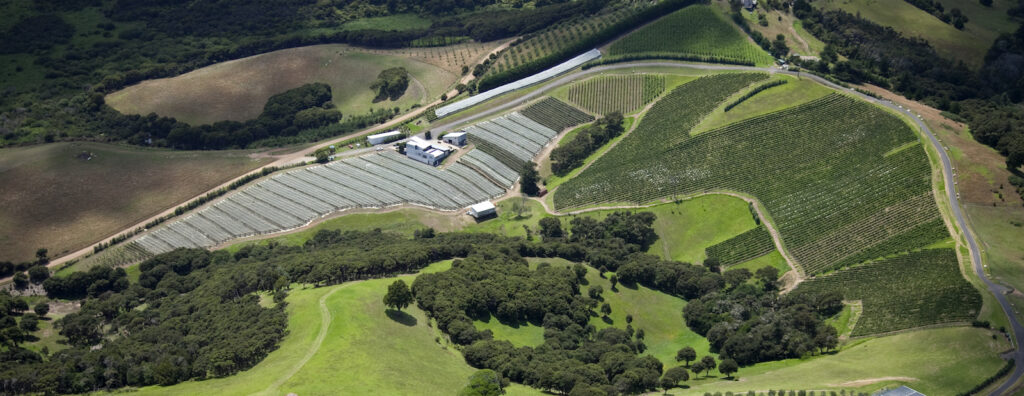
The last class I had to take, to graduate, was a Geography course. And the Professor there was smart enough to teach a ‘World of Wine’ class to meet the Geography requirement. So everybody takes his class, and it is usually the last thing they take to meet their ‘General Ed. requirement’. In one video was the school at UC Davis, and explained how if you’re good at Chemistry and you like to travel, you could get a degree in Viticulture and Oenology, and become a winemaker. And I distinctly remember thinking… “Why did nobody tell me this!?!”
So, lo and behold, 18 months later we’re having this conversation whether I would like to be involved in a vineyard and winery…funny that! We told the story about how everything sort of came together, and it really did feel like destiny. As cliché as it may sound – the vineyard picked us as much as we picked it. Whilst I primarily had an interest in the sciences, I obviously grew up on the consumption side of the wine business. It wasn’t until this opportunity came up, that I started to train towards it – UC Davis, and talking to vintners in California”.
Destiny Bay is about 90% organic. The term ‘organic’ can be confusing because everyone thinks “organic – good… non-organic – maybe not”. But not all things that are organic are good. One of them namely being copper, which is a common organic fungicide – but copper sprays, whilst effective, can toxify the soils. If people wanted to be dogmatically ‘organic’ they could use it;, but there are alternatives that break down better and have a case that they are better for the environment. That is hard for the lay consumer to understand. As Sean comments – “We’ve never been about chasing market trends or trying to greenwash something”.
I often hear that Biodynamics is more of a belief than a science, and I wonder what his opinion is on that?
Sean: “There are beautiful wines that are biodynamic wine, but is that causation or correlation? The argument that I would make about Biodynamics is that if you read Rudolf Steiner – there is stuff that makes sense regardless of what your perspective is. There’s some other things that kind of get a little kooky. More like ritual. And Biodynamics drives people to be micro-focussed on things, because it has all these things that it requires you to spend a lot of time on. The point that I would make is that if you’re spending a lot of time paying attention to your vineyards, then you’re going to make good wine.
We take that same approach. We’ll diverge from Biodynamics from that standpoint, but it is about that attention to detail and managing your vineyard vine by vine – which is something we’ve always done”.
There’s no doubt that Destiny Bay is a beautiful vineyard – looking in fine shape, and Sean is quick to point the praise for that in a certain direction – “The value of having a good quality Vineyard Manager and a good crew who stay on top of things. If we didn’t run a really tight ship on our spray program we would certainly have major disease problems. And I’d point a lot of that to Dan, our Vineyard manager, who has been with us since 2004”.
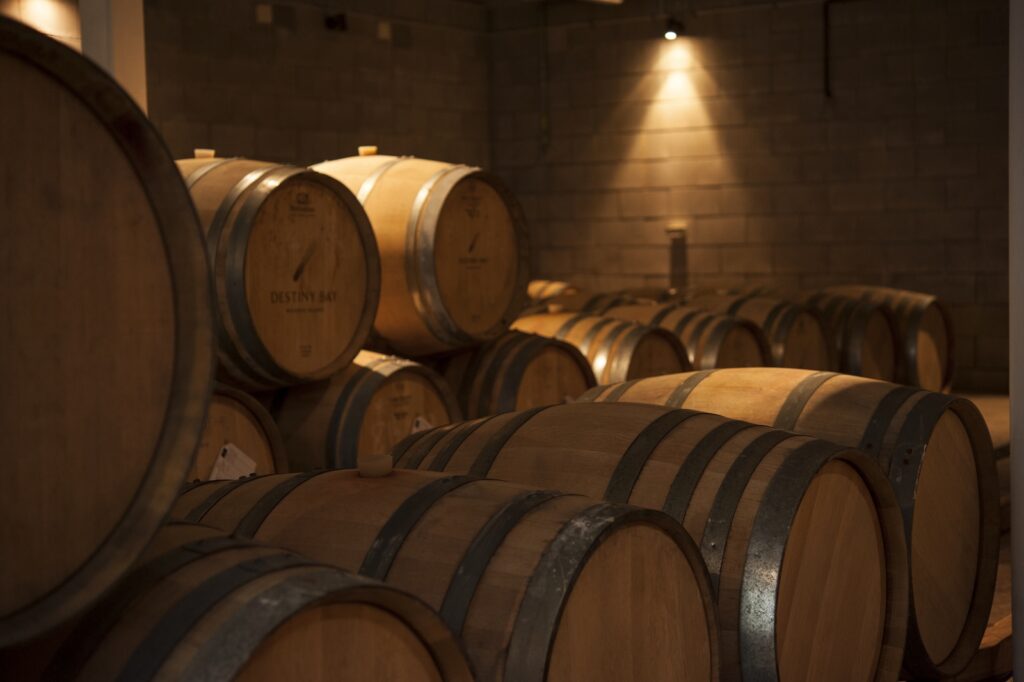
Sean spent time – before creating Destiny Bay – with different wineries and vineyards in California. Ridge up in Santa Cruz crops up in the conversation a few times and Sean is quickly into an enthusiastic explanation:
Sean: “Ridge is sort of my icon winery. Eric Baugher, the senior winemaker for Montebello, has been at Ridge for close to thirty years now and has been an excellent friend and resource. When I was talking to Eric I thought about what I wanted to ask, and I realised that if you ask someone “What should I do?” you get this enormously long list. But if you ask someone “What shouldn’t I do?” – everyone remembers everything they regret. Unfortunately you remember those a lot more. You ask someone about what they regret and you get very specific answers!
Eric’s thing was – “whatever you do – focus on your sorting” Post harvest and pre-crush – that’s an area you really want to focus on. And “However big your fermentation room is, make it 20% wider – and then it’ll still be too small”. I can tell you that that is 100% true. And I was glad I did that and I started asking that same question to every other winemaker I talked to”.
WineFolio: Did something start to form in your mind – a mindset that has carried through to here, now?
Sean: What it really started to shape was our belief here. Which is that – and everyone kind of knows this – great wines are made in the vineyard. But a lot of what goes into making a good wine, is mostly making sure you don’t make a bad wine. You’re never going to get to 100%, try as you might. So what can you do to stack the deck in your favour as much as possible, to make a great wine. And it turns out that a lot of these great wines don’t have a heavy hand on them. They’ve got a pretty light touch.
So, we have this fantastic vineyard site, and our focus was ‘how do we capture what is the taste, profile and character of this terroir?’ And get that from the vine, into a bottle and into a customer’s hand. That really shaped a belief that became our ‘interventionist non-intervention winemaking philosophy’ Ring fence it and prevent everything from those bad things – disease, sub-standard berries…so, how do you sort, how do you capture only high-quality fruit. And if we do that, and keep all that other noise away, then once it gets into the winery, we shouldn’t have to do a hell of a lot. Then the winemaking technique becomes quite traditional and straightforward.
WF: You made the decision to have the winery as close as possible to the grape source then?
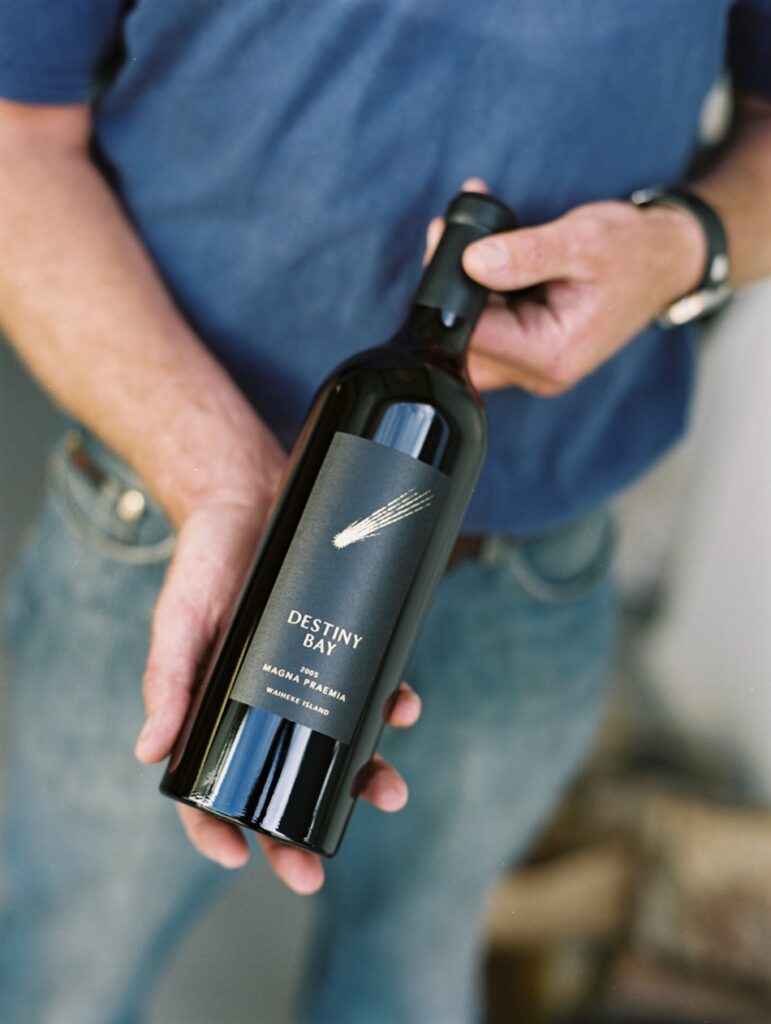
Sean: We realised that the winery and vineyard have got to be close. If we want to capture the vineyard and get it into the bottle, we’ve got to have the winery right here. No grape goes further than 500 metres from the vine to the bottle. It’s a ‘gravity-assist winery’ – we had hoped for ‘gravity flow’ but we learnt on the first vintage you need about a 70% gradient to be true gravity flow! The winery was purpose built, expressly for being efficient and making great wines. It’s a mini Ferrari factory – hopefully. How do we do things at a high quality, efficiently.
We put a vibrating table in underneath the crusher. This photograph shows everything getting sifted out, then we have our ‘optical sorter’ which is a conveyor staffed by about 8-10 people. And we don’t do “good enough”. Which makes the wines expensive to grow, expensive to make, and is a big part of why the wines do cost what they do. This is not a cheap process. That process gets us into the winery.
WF: Do people question why you go to such lengths?
Sean: A lot of people would look at this incredible detail that we go to with sorting – and this is our one or two percent. And they ask “is it really worth all that effort?” So, we did another research project in conjunction with Auckland University’s Wine Science Program. You guys probably know what the technical term is for this – MOG – material other than grape. This is all a MOG-removal process. And when we got to the end of it, we said “look, our wines have got great aromatics – and people will always talk about the fruit and aromatic expression. We think this is playing a big part in it”.
But rather than think about it and be anecdotal, we ran about 36 different microvins in triplicate – made the wines, vinified it, and we had three controls for this – we did different stages which was capturing this, versus, this, versus no sorting at all. Did tasting analysis with people, and of course, predictably, everyone liked the one that is sorted the most… all picking the fully sorted wine as the better wine.
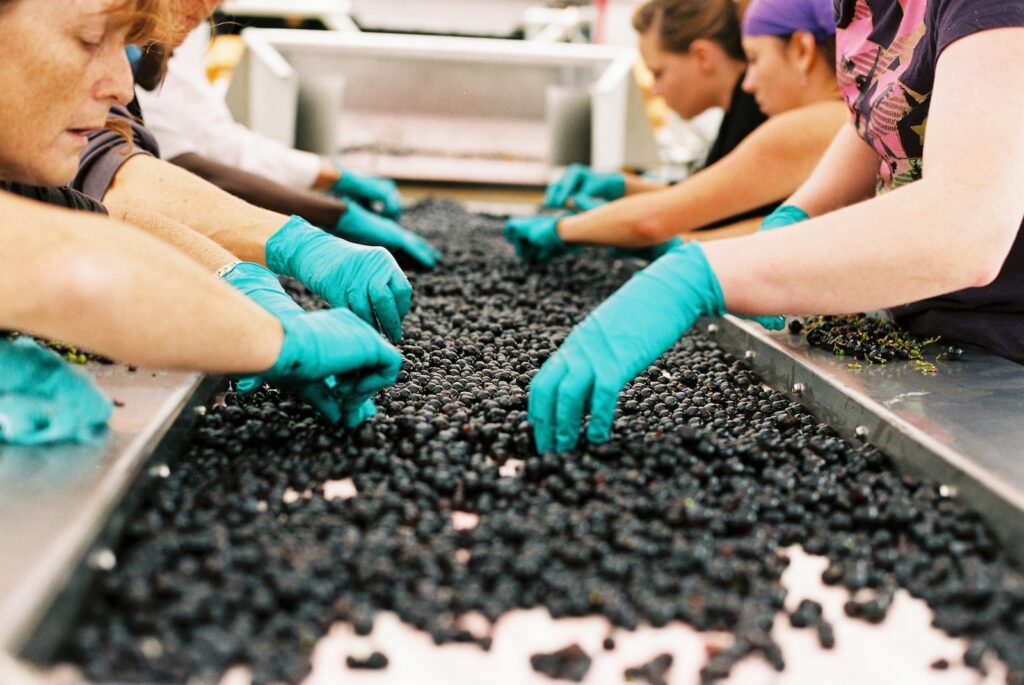
When we looked at it analytically and ran it through HPLC and GCMS which can measure down to the nanogram of compounds, what we found was really surprising. What we found is that we had actually elevated levels of Beta–damascenones in these fruity esters – in the wine that was sorted, which are like the holy grail of aromatic compounds. If you talk to a wine chemist, they are incredibly powerful and are what are used in fragrance companies. Humans tend to be a bit like bloodhounds for these things. We don’t smell too well, but these things we can pick up in parts per trillion. Not parts per million – parts per trillion.
It turns out that what it is – and this is still hypothetical based on the research, and we’d have to do a whole other project to prove this… but we’re pretty sure… is that we changed the ratio.
We concentrated the Beta–damascenones and other aromatic compounds, which lifted it. And if we’re talking parts per trillion, you don’t have to move that needle very far before it starts becoming very evident. We think that is a big reason why this is so important”.
Once the fruit is in the tank, Sean will cold soak – Usually for 72, but sometimes as much as 96 hours to get the water-soluble compound extraction. There is a lot of evidence that a cold soak improves aromatic retention.
So between the cold soak and the colossal effort at sorting, he considers that the two things are playing together to really elevate those beautiful fruit characters and aromatics. As it is coming out of cold soak it will start to warm up naturally. I ask Sean what happens next…
Sean: There are some great naturally fermented wines, but they can be unpredictable. And my belief is that while a totally wild and natural ferment can create a great wine, and often does, you do start to have this effect where the natural yeast are starting to put their own influence on the wine. And that is not really what we’re looking for. We’re trying to make sure “are we capturing the vineyard?”.
WF: But isn’t that part of it? If you’re trying to capture that truth?
Sean: Not if you’re trying to capture what are the vines doing? There’s going to be different yeasts every year, but if you are looking to say what is it doing from the yeasts and the vines all on its own – that’s perfectly fine, and you can make great wines that way. But that’s not what we’re looking for. So while we might get a natural ferment starting for the first couple of brix, we do then introduce yeast. Because then we are getting consistency, and what the vineyard expression is – versus yeast variability.
WF: At what point do you make the call to press off?
Sean: Once we’re satisfied with it from an extraction and balance standpoint when we’re tasting off, then we’ll make the decision to press. At that point we’ll drain off the tanks by gravity and we keep that free run juice separate. We throw someone in there with a food grade shovel and what is in there goes into the press just down below us, and we’ll begin to press off. So we’re capturing the free runs and the press fractions separately.
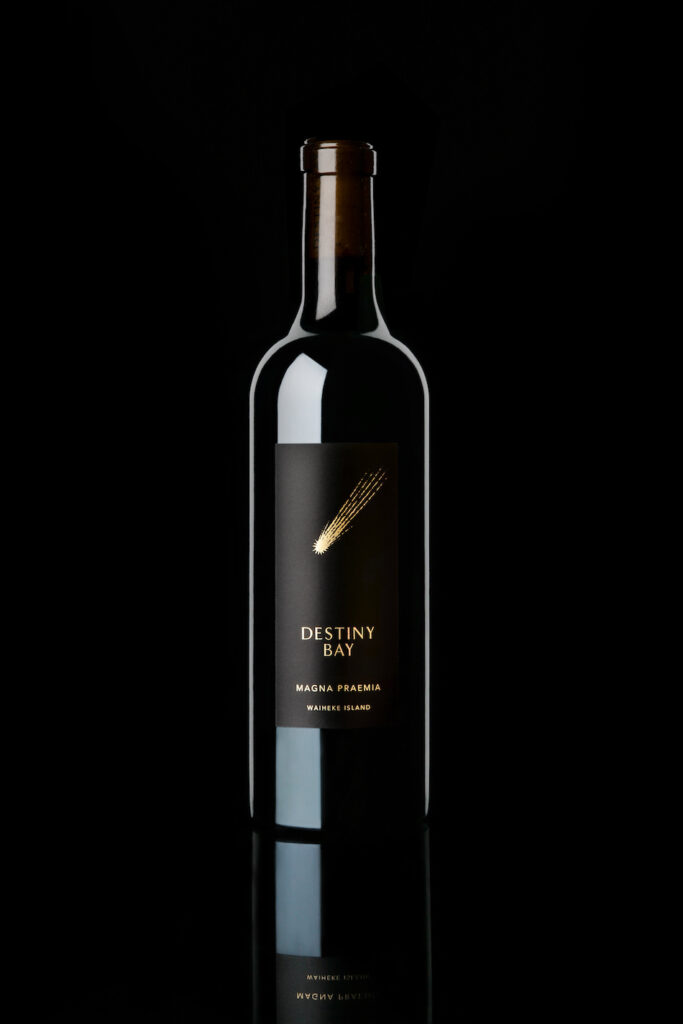
They make three blends at Destiny Bay – Destinae, Mystae and Magna Praemia. Destinae is the essence – that from which destiny is made – and is a good snapshot of the whole vineyard. It has got a pretty even blend of Merlot and Cabernet, but if you wanted to see what any one given vintage was like, then you can see the most varieties at play and in balance with each othet in Destinae. It also tends to use a little bit more of that free run which means it is more fruit-driven. Mystae, is named after the greek followers of Dionysus – the scientists, philosophers and artists, who they pondered the mysteries of the universe. That is usually about 50-60% Cabernet and starts to use more of the press fractions which add a different texture and character to it. And then Magna Praemia, which is latin for ‘great rewards’ and that is dominated by Cabernet Sauvignon and more of those middle to deep press fractions.
WF: I have a question that I’d thought of before I came out here – isn’t it unusual – to be using pressed wine fractions in your best wine?
Sean: Now, a lot of winemakers will tell you they hate their pressed wine, and I would agree – if you don’t do all that sorting. Because if you leave all that stuff in there and you start to squeeze that out, you’re going to end up with stuff that is pretty unattractive. And the free run is going to look the best. But if you pull all that out and squeeze all that, you start to get something very different and lovely characteristics. And that is important.
We start to taste some of the 2021 wines from barrel – we are some of the first people to taste the 2021 vintage, which was just blended a couple of weeks ago. We start with Destinae, which is 35% Cabernet Sauvignon, 32% Merlot and then 12% of Franc and Malbec, then the rest is Petit Verdot.
WF: This is nicely structured. A wonderful mid-palate red fruit character, with redcurrant and cranberry. I love the cassia, nutmeg spice in that. I’m getting a pink peppercorn note there too.
Sean: This is Mystae – about 54% Cabernet sauvignon, with Franc and Merlot down in the 20s. More press fractions, so you’re going to get more Cabernet character coming through. The only person who has tried this from outside is Bob Campbell, who was here on Monday with me.
WF: The Cabernet really sets the tone here doesn’t it? That cassis bon-bon flavour. The mid palate just goes way back, and with that pop in the middle. I sometimes find Cabernet has that doughnut effect? This doesn’t.
Sean: That is very much the reason why when we have tried playing around with much higher Cabernet in the blend. With Magna Praemia which is what you’ll be trying now it is usually in the mid-70s. I’ve had great years, with great ripe Cabernet, and tried taking it to 80 or 90% – and it is a lesser wine. It just absolutely is not as good as if we keep it around that 70% and give enough Franc, Merlot and Malbec to take care of that doughnut effect.
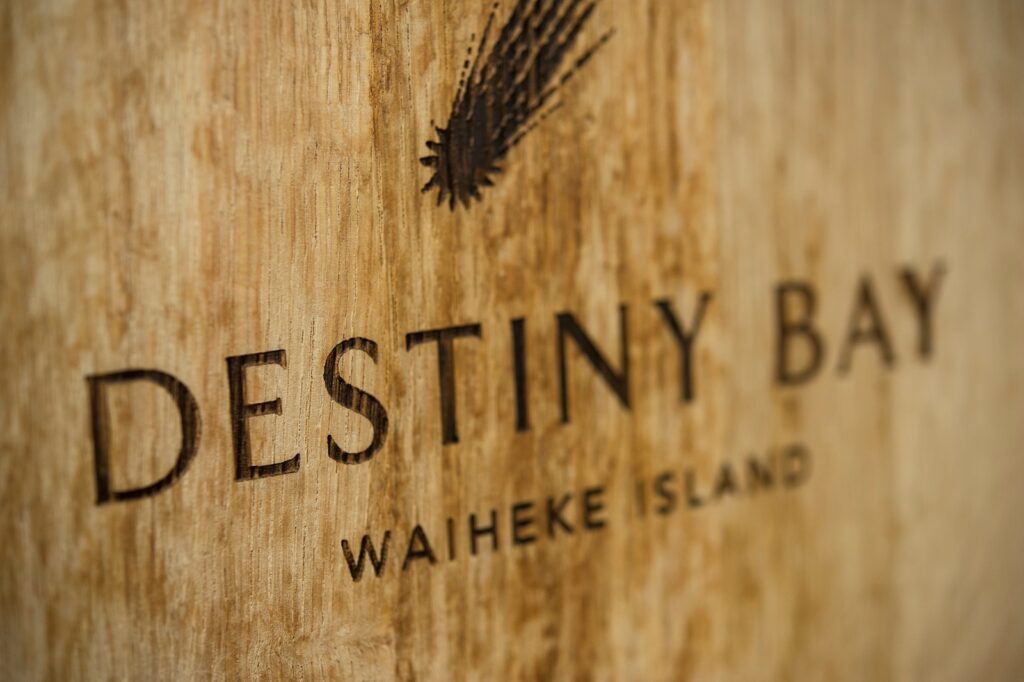
WF: I know Petit Verdot is sometimes called ‘supercharged Cabernet’ – so that’s perfect… but how well does it ripen out here?
Sean: Everyone talks about how hard it is to get Petit Verdot ripe. “It’s the last thing to come in, and some years we don’t even have it”. I don’t know how to explain this, but Petit Verdot is usually the second variety to come in. At like 26 brix! It comes in at the time our Merlot and Malbec comes in. so getting it ripe does not seem to be a problem for us.
WF: I find that root beer, sarsparilla character really appealing in that – is it just that one barrel do you think?
Sean: Possibly. Even though these were recently blended just three weeks ago, I am already noticing variations and barrel characteristics coming out.
I did the blending earlier this year as I was scared of getting Delta as I can’t afford to lose my sense of smell. I jumped on it a little bit early. I actually prefer to hold until January if I can.
WF: That has got immense power, drive and it’s quite seductive though. Amazing tannins – soft and seamless already.
Sean: It has got another 6 months in barrel, but you could almost drink that now. This wine is going to cellar for ages, so it is not too light either. That’s a deceiving thing – if you’ve got really ripe tannins – long tannin chain structures – which are going to taste sweeter. It can be deceptive for a lot of people because they’re expecting something to be aggressive.
We head back upstairs and find a series of wines and glasses laid out for tasting.
You had the chance to try the three wines side by side, so you can see what each one looks like. Then I asked Ella to bring out some different wines from different vintages to look at. We’ll start with the Destinae 2010. That was a great vintage. Very ripe and very Mediterranean style vintage.
WF: I’m getting that there’s a good amount of Cabernet Franc in there. It opens up very violet perfumed and sensual, and then takes a dive into a mushroomy, mocha, earthiness but with nice depth.
Sean: It’s a good example of what I refer to as the ‘Franc funk’. The difference often between our A, B and C blends of Magna Praemia when we put it together as two or three different versions to see what can be the final blend, is usually only a shifting of the Franc by 2-3 percent. Still bright – good acidity – still looking like a baby.
WF: The alcohol is quite moderated too, it doesn’t feel like a huge ripe 15 percenter.
Sean: The most we’ve ever made anything is about 14.5%. Ideally, I’d love to make them about 13.5, but trying to get the ripeness versus alcohol balance – I would be compromising on ripeness in some cases. It takes just the perfect vintage here to have it at 13.5% and still have that ripeness, so usually we find the sweet spot for these vineyards and this wine is around 14%.
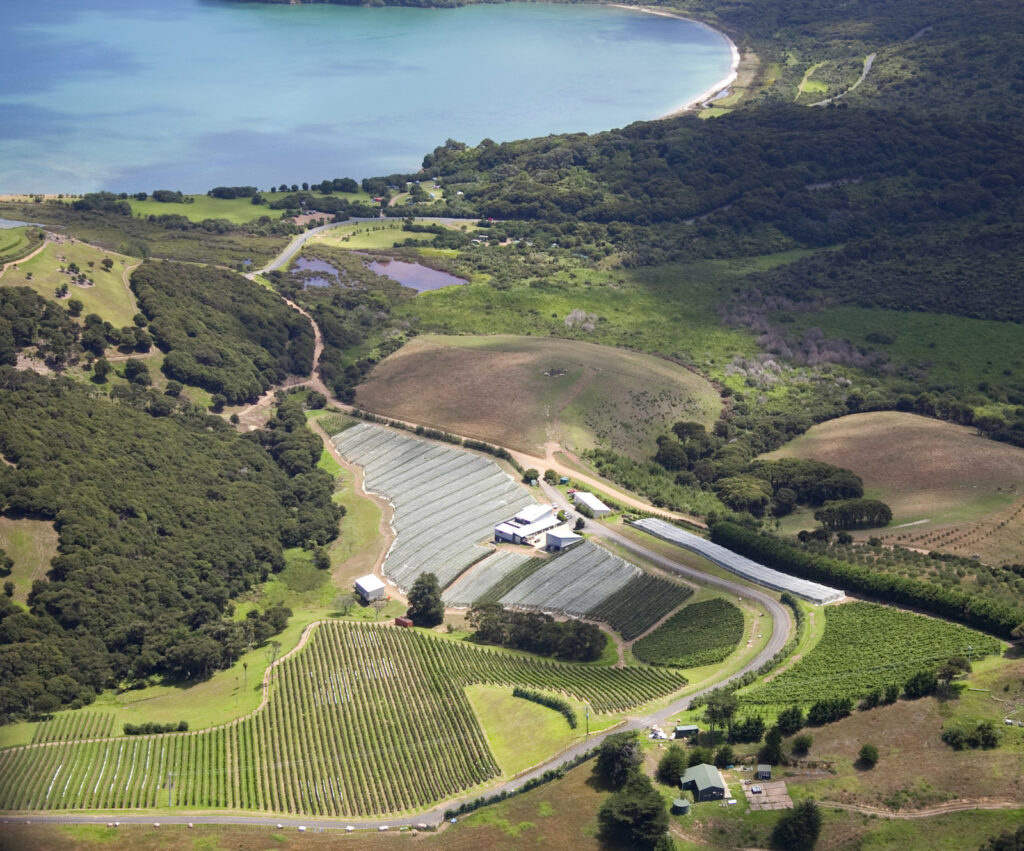
Now you’re looking at Mystae 2015. Great vintage in terms of density and structure. 48% Cabernet and 30% Merlot. And the Magna Praemia 2019, which after Bob gave it 99 out of 100 is the one that tipped us into getting Winery of the Year with the Real review. I don’t normally open this one up all the time.
WF: Delicious cedar, graphite pencil shaving on the nose. There’s that cassis again. People often ask me what is the difference between good wine and great wine. It’s the little details in a wine like this that makes the difference, that 1%. Like the barrel sample we had – it has tremendous power and length. Lovely savouriness for a wine that is so new and youthful.
Sean: That’s that focus on the oak, some characters are more oak characters than they are fruit characters. You talk about the merlot in particular having that ‘box of chocolates’ kind of character to it. We’ve whittled our oak choices down to about three coopers, and in the American oak there is two toasting regimes. For the French oak we stick to a very specific toast from that cooper.
We actually use some American oak barrels with a bourbon coopering style. It’s a winemakers toast, but it is actually a bourbon barrel. They are 200 litres, and steam bent rather than fire bent. You’ve got an increased wood to juice ratio by the virtue of it being a smaller barrel, but then it is tempered a little bit by that steam-bending process. It extracts out a little bit of tannins. We use about 20 to 25% of these.
WF: Do you have an idea of how long something like a Magna Praemia would be best cellared for, and would there be a sweet spot drinking window?
Sean: I haven’t been making this wine long enough to definitively say! The 2008 Magna Praemia is still on its way up. This is a real tough one for me, and I get asked it a lot. For me, personally, as a wine consumer, don’t tend to enjoy really advanced ageing in my wines. When I’ve had the opportunity to try something like a vertical of Grange, going back to 1987… everyone else will be raving about the ’87 and the ’92 and I’ll be trying the ’98 and going “actually, that’s my favourite”. A lot of it is personal preference driven.

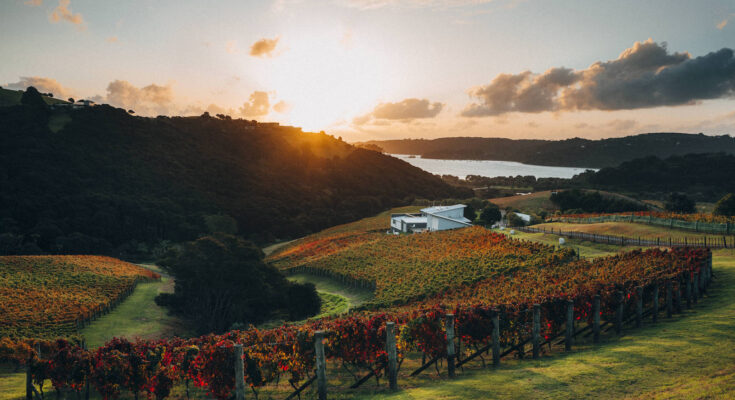
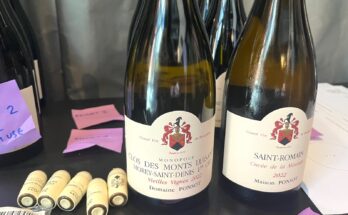
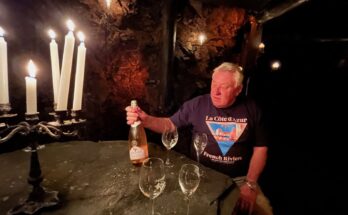
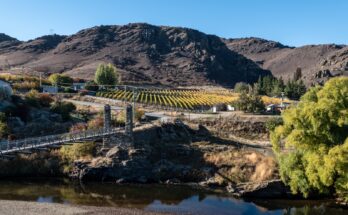
2 Comments on “Only the best – Destiny Bay, Waiheke Island”